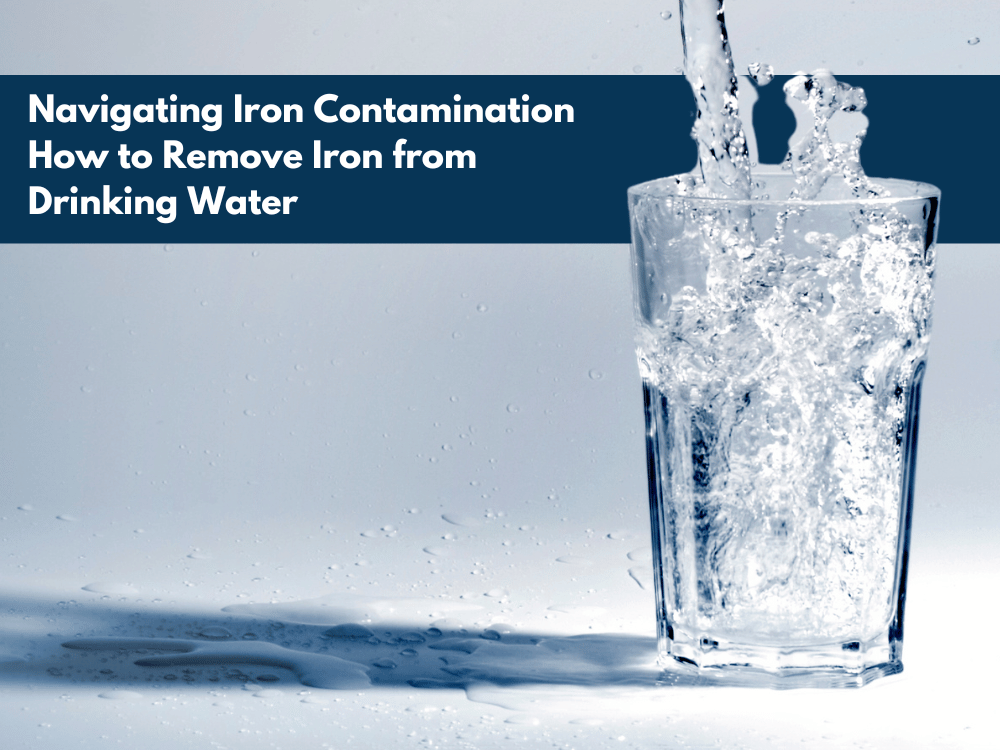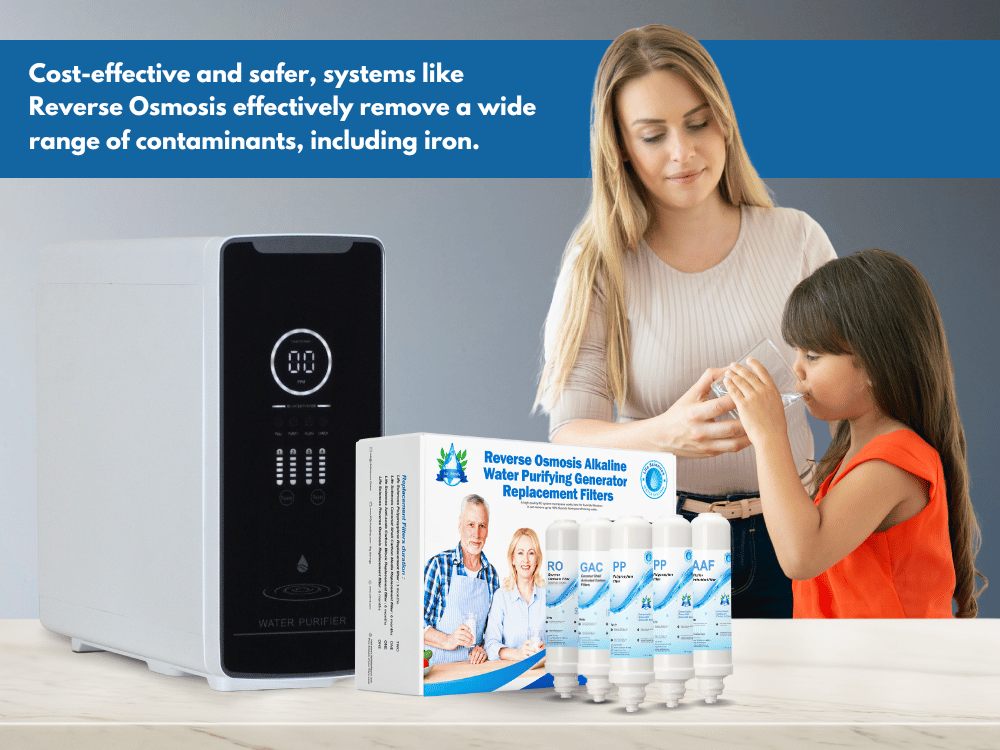Empower Yourself: Understanding the Hazards of Iron in Your Tap Water
Discover the potential dangers lurking in your tap water as we delve into the widespread issue affecting millions of Americans—iron contamination. With approximately 30 million Americans consuming water with elevated iron levels, it’s crucial to be informed about the challenges this common element presents in drinking water. Join us as we explore the various forms of iron, associated health concerns, and effective filtration solutions.

Decoding the Different Forms of Iron in Water
1. Ferrous Iron: The Transformative Menace
Ferrous iron, initially soluble, transforms into the visible, staining ferric form when exposed to atmospheric conditions. Typically found in deep wells with limited sunlight exposure, ferrous iron contributes to unsightly staining in pipes, showerheads, and fixtures.
2. Ferric Iron: The Stubborn Challenge
In its insoluble form, ferric iron occurs naturally through the oxidation of iron. Recognizable by its reddish or orange appearance, ferric iron often leads to clogs in pipes and fixtures, causing inconvenience in households.
3. Bacterial Iron: The Unseen Menace
Formed when bacteria bond with iron, this results in a slimy red residue. Bacterial iron contamination is prevalent in well water due to factors such as lack of maintenance, broken pipelines, or poor sanitation practices.

Impacts on Taste, Food, and Aesthetics
1. Taste and Food Quality
Dissolved ferrous iron imparts a metallic taste to water, affecting beverages and darkening vegetables during cooking. Understanding these effects is crucial for maintaining water quality and enhancing culinary experiences.
2. Stains and Deposits
Even at low concentrations, iron (0.3 mg/L) can lead to persistent reddish-brown stains on fixtures and laundry. Awareness of these staining effects is essential for maintaining a clean and aesthetically pleasing environment.
Iron in the Environment: Air, Water, and Food
1. Air Quality Measurements
- Remote areas: 50–90 ng/m³.
- Urban sites: Approximately 1.3 µg/m³.
- Proximity to iron- and steel-producing plants: Levels may reach up to 12 µg/m³.
2. Water Composition
- Median iron concentration in rivers: 0.7 mg/liter.
- Anaerobic groundwater: Typically 0.5–10 mg/liter, occasionally up to 50 mg/liter.
- Drinking water: Usually below 0.3 mg/liter, but higher in areas using iron salts in water treatment.
Human Exposure and Health Effects
1. Daily Iron Intake
- From food: 10–14 mg.
- Drinking water (0.3 mg/litre): Contributes 0.6 mg to daily intake.
- Urban air: 25 µg/day.
2. Health Effects of Iron in Drinking Water
Crucial for transporting oxygen into the blood, tap water contributes approximately 5 percent of the dietary iron requirement. However, high iron content poses health risks, including diabetes, hemochromatosis, stomach problems, nausea, and potential damage to vital organs.

Navigating Iron Contamination: How to Remove Iron from Drinking Water
To address iron presence in drinking water, a strategic approach is crucial. Here are actionable steps:
City Water: Access Your Free Water Quality Analysis Report
- Obtain a complimentary water quality analysis report from Life Water Report.
Well Water: Understand Your Water’s Composition
- Have your well tested to identify specific iron types and concentrations.
Choose the Right Filtration System
- Tailor your choice to your water’s unique composition. Water softeners and specialized iron filters prove effective depending on iron content.
Consider Shock Chlorination for Intensive Treatment
- Disinfect well water to eliminate bacteria binding with iron before filtration.
Opt for Water Filtration Systems
- Cost-effective and safer, systems like Reverse Osmosis effectively remove a wide range of contaminants, including iron.
Life Water Report: Your Source for Water Quality Insights
At Life Water Report, we go beyond providing information. We offer a detailed water quality analysis report, empowering you with insights into the health of your water. Our process is simple:
Visit Our Website:
- Navigate to our website and click on the “Get Your Free Water Quality Analysis Report” link.
Receive Your Report:
- Get a comprehensive water quality analysis report delivered to your inbox, by entering your email and area zip code detailing the composition and potential contaminants in your water.
Innovative Solutions: Life Sciences™ Water Filtration Products
Life Sciences™ presents cutting-edge solutions to combat iron contamination:

Reverse Osmosis Alkaline Water Purifying Generator
- Removes up to 98% of contaminants, fortified with essential minerals.
- Includes a Borosilicate Glass Water Pitcher for enhanced alkaline water.
- Priced at $597 with a lifetime warranty.
What is a Stainless Steel Infuser? This insert, which is inside your Bonus Borosilicate Glass Water Pitcher,
allows you to pour your purified Alkaline Mineral Water inside and then make a variety of Alkaline Mineral Beverages. For coffee & tea, your Life Water Pitcher can be heated up on the stovetop. Alkaline Mineral Water coffee and tea are much better tasting than the same brew in tap water. Takes away that acidic taste!
Plus you can make herb or fruit alkaline beverages that are healthy and tasty! click here
Hydrogen Alkaline Bio Energy Water System
- The 5-stage filtration process removes impurities, including iron.
- Enhances water quality with activated carbon, ultrafiltration, and an Alkaline Antioxidant Filter.
Borosilicate Glass Life Water Pitchers
- Ideal for cold water storage and serving fresh alkaline mineral water.
- Durable and temperature-resistant, enhancing the aesthetic appeal.
Elevate Your Hydration Experience with Life Water Report
Upgrade to the future of hydration with Life Water Report’s advanced water quality insights. Our water quality analysis reports go beyond the ordinary, providing a detailed overview of your water’s composition. Trust us for unparalleled advanced water filtration systems.
For more information and to get your free water quality analysis report, click here.
